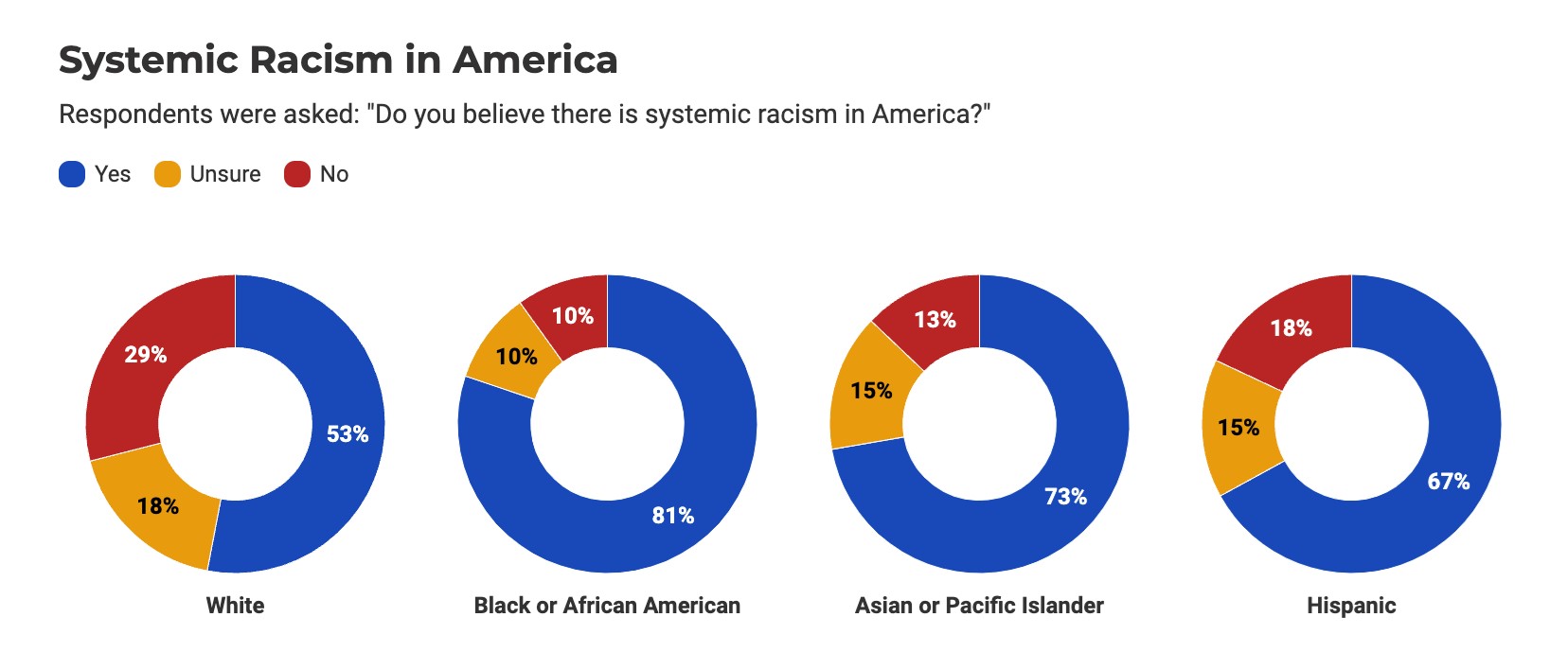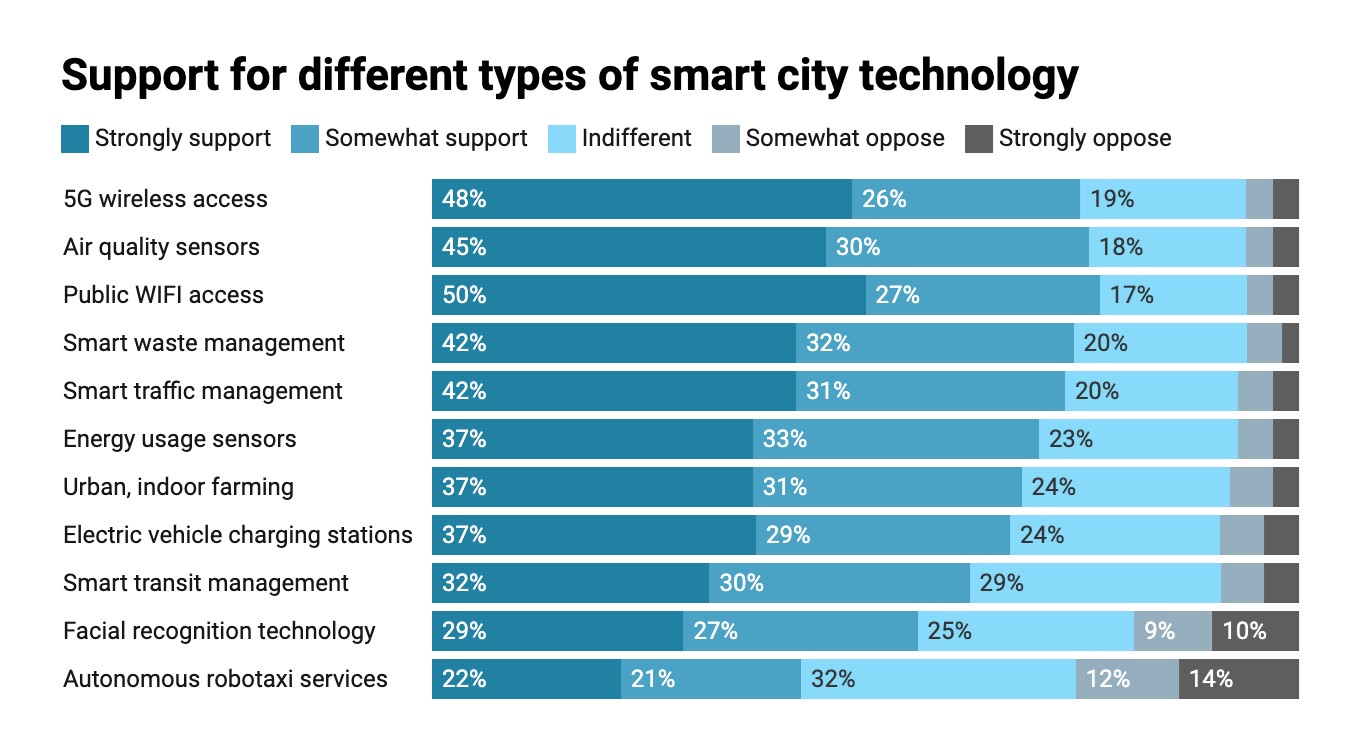Los Angeles Rams and ARound Introduce the Next Generation of Stadium Augmented Reality, Sponsored by SoFi
ARound Expands Stadium-Wide AR With Addition of In-Venue Broadcast Integration on SoFi Stadium’s Infinity Screen, In-Home Fan Experience; SoFi Signs on as First ARound Brand Sponsor
LOS ANGELES and NEW YORK – Dec. 5, 2022 – The Los Angeles Rams are introducing a new fan-focused technology experience at the stadium and at home. Debuting at yesterday’s game, fans at SoFi Stadium were the first to experience shared augmented reality (AR) in an NFL game with the launch of ARound, a next-generation fan engagement platform designed to enhance gameday fun with live, real-world AR experiences, sponsored by SoFi, digital personal finance company and SoFi Stadium naming rights partner. First launched in August with the Minnesota Twins, ARound expanded its platform to include in-venue broadcast integration as well as an at-home AR experience.
ARound, part of the Stagwell Marketing Cloud, uses 3D spatial computing to localize content to individual users throughout the venue, enabling SoFi Stadium’s 70,000 attendees to see the same real-time 3D effects and participate in the same shared experiences. Using the ARound Stadium app, fans point their smartphone at the field to open up a universe of AR effects, interacting with the physical venue and fellow fans in real time. ARound and the Rams have taken shared AR several steps further through new fan experiences custom to the Rams and to the NFL:
- Infinity Screen AR: Fans can view effects like “Rampede” and “Make Noise” come to life on the Rams’ state-of-the-art 70,000-sq. foot videoboard, The Infinity Screen, with AR experiences incorporated into the gameday production in real time, such as when a touchdown is scored or when the team takes the field.
- Players in 3D: Key player callouts including Aaron Donald, Bobby Wagner, Cooper Kupp, Jalen Ramsey, Matt Gay, and Matthew Stafford are featured through special effects, making their personalities larger than life.
- The Best Seat in the House, At-Home AR Experience: Fans can join the gameday festivities and contests through a life-size virtual stadium experience from their homes, mirroring what’s happening during the game at SoFi Stadium.
- SoFi: Official ARound Sponsor: Opening the door to this new, connected marketing medium, digital personal finance company and SoFi Stadium naming rights partner SoFi has signed on as ARound’s first platform partner with stadium-wide AR games, contests, effects, and a remote experience amplifying the energy and excitement of Rams gamedays and the SoFi brand.
“We are thrilled to team with ARound and SoFi to incorporate AR into gamedays at the Rams House in unprecedented ways,” said Marissa Daly, VP & GM, Los Angeles Rams Studios. “This experience is a continuation of the game-changing ways we’ve partnered with SoFi at SoFi Stadium and across Los Angeles to elevate the fan experience on gamedays and beyond.”
“Fans come to the stadium to feel closer to the game, to the players, and to other fans. We developed ARound to enhance those feelings through highly immersive and interactive AR experiences that complement the action on the field,” said Josh Beatty, founder and CEO, ARound. “And with products like Apple and Google AR Glasses already in development we’re excited to open up the living room to blended TV experiences we know are the future of broadcast entertainment.”
“At SoFi, we pride ourselves on being at the forefront of innovation to create seamless experiences for our members, all while fulfilling our mission of helping our members achieve financial independence,” said Lauren Stafford Webb, CMO, SoFi. “We are proud to sponsor ARound’s first-of-its-kind technology for Los Angeles Rams fans at the iconic SoFi Stadium to make their experience even more spectacular.”
Journalists interested in covering the Rams launch can access the press kit here.
About ARound
ARound is a first-of-its-kind stadium-level shared augmented reality platform and is part of the Stagwell Marketing Cloud, a proprietary suite of SaaS and DaaS solutions build for the modern marketer. ARound keeps audiences engaged by capturing their attention through immersive, interactive and shared experiences with fellow fans across the venue. Where other AR products offer isolating, singular experiences, ARound’s massive multi-user AR – which uses 3D spatial computing to localize content – redefines what it means to be part of a connected fan experience. It was the winner of Stagwell’s annual innovation competition which invests in new product ideas proposed by the network’s 13,000+ employees. ARound and the Stagwell Marketing Cloud are a part of Stagwell (NASDAQ: STGW), the challenger network build to transform marketing.
About Los Angeles Rams
The Los Angeles Rams – Los Angeles’ original professional sports team and Super Bowl LVI Champions – stand as one of the oldest franchises in the National Football League and since its founding in 1937, have garnered four World Championships and sent 30 of its members to the Pro Football Hall of Fame. As a professional sports team, the organization is committed to be a valuable civic partner and serving the greater Los Angeles area 365 days a year. The Rams play their home games at SoFi Stadium, which is located at Hollywood Park, a 298-acre sports and entertainment destination being developed by Los Angeles Rams Owner/Chairman E. Stanley Kroenke in Inglewood, CA.
About SoFi
SoFi helps people achieve financial independence to realize their ambitions. Our products for borrowing, saving, spending, investing and protecting give our over four million members fast access to tools to get their money right. SoFi membership comes with the key essentials for getting ahead, including career advisors and connection to a thriving community of ambitious people. SoFi is also the naming rights partner of SoFi Stadium, home of the Los Angeles Chargers and the Los Angeles Rams. For more information, visit SoFi.com or download our iOS and Android apps.
Related
Articles
In the News, Press Releases, Thought Leadership
Jun 10, 2025
Stagwell (STGW) Chairman and CEO Mark Penn to Discuss the Irreplaceable Power of Human Creativity on the Main Stage of Cannes Lions

Events, In the News, Press Releases, Talent & Awards
Jun 05, 2025
Code and Theory Named ANA B2B Agency of the Year After Transforming the World’s Leading Brands

In the News, Press Releases, Talent & Awards
May 19, 2025
Stagwell (STGW) Appoints Connie Chan as Chief Growth Officer for Asia Pacific

Newsletter
Sign Up
By
By: Adrienne Adair, SVP, Creative,
MMI Agency
Originally Released in
MediaPost
CONTACT
hello@stagwellglobal.com
SIGN UP FOR OUR INSIGHTS BLASTS
Creating content at a pace that continues to grow in response to consumers’ appetites can feel daunting. That each creative asset further needs to grab the audience’s attention in the first three seconds, and bears the responsibility of resonating with that consumer and garnering a like, click or sale, only adds to the challenge.
Continually optimizing performance is the key to a successful and diverse content strategy, and that requires a carefully orchestrated flights of assets to launch, test and learn to immediately develop the next round. The cadence of those assets must be constant and unwavering: assets that vary by message and by imagery. Static assets. Animated assets. Influencer’s assets. Now, multiply those assets by the number of unique audiences.
Given these challenges, how do we preserve the ability to curate original work without blowing the budget in the time it takes to produce it? AI can put invaluable time back in the hands of creatives by using features that allow designers to crowd-share a project in real time to finish a layout in far less time than had been possible.

Web and mobile apps are available to create content quickly through customizable templates and access to thousands of fonts. They can even intuitively reflow your layout from one size to multiple formats with a single click and allow you to publish the content to your social channels directly from the app. AI can be used to analyze and extrapolate an image from simple to complex backgrounds more quickly than with the original image selection tools, enabling designers to composite multiple images in one layout at breakneck speed.
There are also innovations still in development that promise to speed up the work of designers such as AI’s predictive technology that can uncrop portraits, not only showing a cropped subject in full frame, but also giving designers the ability to change the wardrobe or the surrounding background — all with a few clicks.
Want to create a motion video from a static photo? AI can analyze the motion from a selected source video and apply it to a static photo, allowing designers to make stationary subjects dance. Another such innovation on the horizonwill allow easy creation of packaging mocks that apply 2D design elements to 3D packaging composites, reducing an hours-long exercise to just minutes with a single click.
Why should brands be interested in how AI has enhanced these tools of the trade? Because time = money. If the shortest distance between two points is a straight line, the path from imagination to realization on behalf of your brand is more direct than ever.
With these tools, tasks that once took four hours might take as little as 40 minutes. From pandemic repercussions to supply chain limitations to inflation, brands are challenged to make the same level of impact in the market with more conservative budgets. The time saved in production allows more time for creativity and more time to produce a greater number of the most impactful assets to amplify your brand’s presence and maximize performance.
Related
Articles
Artificial Intelligence, In the News, Marketing Frontiers, Press Releases, Stagwell Marketing Cloud, Tech
Jun 12, 2025
PRophet, a Stagwell (STGW) Company, Completes Integration of UNICEPTA, Launches Unified Brand and Enhanced Media Intelligence Offering

In the News, Marketing Frontiers, Press Releases, Stagwell Marketing Cloud, Tech
Jun 11, 2025
The Marketing Cloud Launches Cutting-Edge Platform to Simplify Marketing Workflows
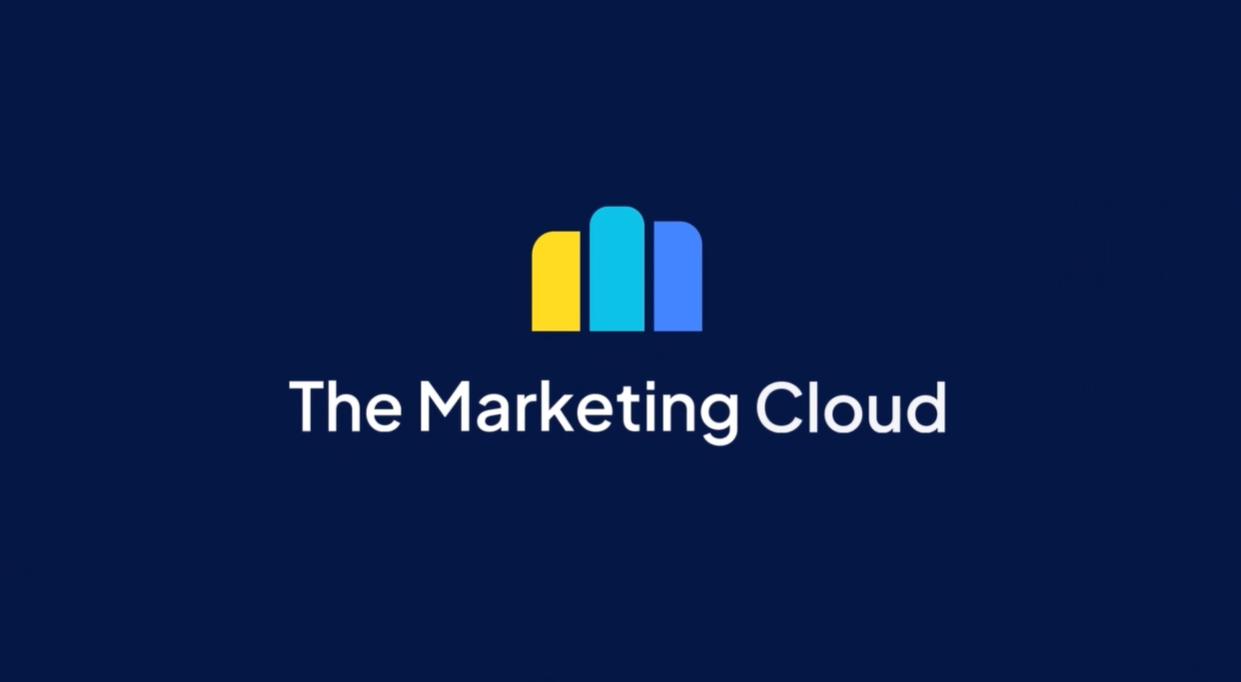
In the News, Press Releases, Thought Leadership
Jun 10, 2025
Stagwell (STGW) Chairman and CEO Mark Penn to Discuss the Irreplaceable Power of Human Creativity on the Main Stage of Cannes Lions

Newsletter
Sign Up
By: Ray Day
CONTACT:
We wanted to share our latest consumer and business insights, based on research from The Harris Poll, a Stagwell agency.
Among the highlights of wave 142 (fielded Nov. 11-13) in our weekly consumer sentiment tracking:
WORRIES MODERATE ACROSS THE BOARD:
Today, 86% of Americans are concerned about the economy, inflation and jobs – down 2 points from last week. In fact, all worries we track moderated this week.
-
- 83% worry about a potential U.S. recession (down 1 point)
- 80% about U.S. crime rates (down 4 points)
- 72% about political divisiveness (down 3 points)
- 71% about affording their living expenses (down 5 points)
- 70% about the War on Ukraine (down 2 points)
- 56% about a new COVID-19 variant (down 3 points)
- 45% about losing their jobs (down 3 points)
- 40% about the Monkeypox outbreak (down 4 points)
INFLATION KEEPS GEN Z LIVING AT HOME:
Inflation and uncertain economic times are keeping more than half of Gen Z living at home with their parents, according to our study with DailyPay.
-
- 54% of 18-to 25-year-olds have made the choice to live with their parents given the current economic climate.
- Only 28% say they are typically able to pay all of their bills on time.
- 80% feel the economy will either stay the same or decline during the next 12 months.
- 41% are worried it will be tougher to pay bills due to high inflation, and 38% are concerned it will make buying staples/food more challenging.
- 78% say they have been able to save less money.
- One solution: 72% of employed Gen Z members say having access to their pay every day – as opposed to waiting until a scheduled payday – would help them pay bills on time.
LARGE NUMBER OF AMERICANS NOT CONVINCED RACISM IS AN ISSUE:
Despite the toll the pandemic and its economic fallout have had on communities of color during the last two years, more than 40% of Americans today are not convinced that systemic racism exists, according to our “The State of Equity In America” report with U.S. News & World Report.
-
- In fact, nearly a quarter of Americans believe there absolutely is not systemic racism in America, while another 17% are unsure.
- Nearly half (47%) of White Americans remained unconvinced.
- More than 80% of Black Americans believe it does, as well as more than 70% of Asian or Pacific Islanders and nearly 70% of Hispanics.
- For business: Only about one fifth to one quarter of respondents believe companies have put in a “very good effort” during the past two years to advance racial equity.
- Both White Americans and people of color have less trust in government to make meaningful changes in advancing equity and more faith in small businesses, nonprofits, and educational and health care entities.
- Among people of color, 73% trust small businesses to some degree to advance equity – the highest level of support given to a range of institutions that also included corporations and religious groups – as do 78% of White Americans.
MORE THAN HALF OF AMERICANS READY TO BUY AN EV:
The scales continue tipping toward electric vehicles – with 51% of U.S. adults saying they would like to buy an electric vehicle as their next car, according to our survey with Protocol.
-
- Millennials are the most likely to be ready, with 61% saying they want an EV.
- 72% of all people think EVs will become more common than traditional gas-powered vehicles in their lifetime.
- We also surveyed consumers on their attitudes toward public transit as an alternative mode of transport. A quarter of all respondents report regularly using public transportation, with the largest segment in the Northeast.
- 64% view public transportation where they live as trustworthy.
- 38% of U.S. adults are less willing to use public transportation post-COVID, including 44% of Northeast residents.
- 46% of Gen Z respondents are less willing to use public transit as a result of the pandemic.
CHARITIES INSULATED FROM INFLATION CUTBACKS:
One in four Americans are increasing charitable giving due to inflation, according to our survey with Vanguard Charitable. In addition, more than half (60%) of American donors say rising inflation is having no impact on their giving.
-
- 45% of American donors have an annual charitable giving budget, similar to the year prior (44%).
- 74% of Americans donated to charity in past 12 months, with younger Americans (ages 18-44) being more likely to say they donated more money than they normally would as a result of inflation, compared to older Americans (ages 45+) (18% for younger versus 8% for older).
- 86% of Americans who have a charitable giving budget say it is important for them to support charities financially during times of economic uncertainty.
- Donors who have a charitable giving budget are two times more likely to say they plan to give more than normal compared with donors without a charitable giving budget (20% versus 10%).
ICYMI:
In case you missed it, check out some of the thought-leadership and happenings around Stagwell making news:
As always, if helpful, we would be happy to provide more info on any of these data or insights. Please do not hesitate to reach out.
Thank you.
Related
Articles
In the News, Press Releases, Thought Leadership
Jun 10, 2025
Stagwell (STGW) Chairman and CEO Mark Penn to Discuss the Irreplaceable Power of Human Creativity on the Main Stage of Cannes Lions

Events, In the News, Press Releases, Talent & Awards
Jun 05, 2025
Code and Theory Named ANA B2B Agency of the Year After Transforming the World’s Leading Brands

In the News, Press Releases, Talent & Awards
May 19, 2025
Stagwell (STGW) Appoints Connie Chan as Chief Growth Officer for Asia Pacific

Newsletter
Sign Up
By: Ray Day
CONTACT:
We wanted to share our latest consumer and business insights, based on research from The Harris Poll, a Stagwell agency.
Among the highlights of wave 141 (fielded Nov. 4-6) in our weekly consumer sentiment tracking:
ECONOMY, INFLATION WORRIES TICK BACK UP:
Today, 88% of Americans are concerned about the economy, inflation and jobs – up 2 points from last week. Worries about affording living expenses, in particular, jumped significantly.
-
- 84% worry about a potential U.S. recession (up 1 point)
- 88% about the economy and inflation (up 2 points)
- 84% about U.S. crime rates (up 2 points)
- 76% about affording their living expenses (up 4 points)
- 75% about political divisiveness (up 1 point)
- 72% about the War on Ukraine (no change)
- 59% about a new COVID-19 variant (down 3 points)
- 48% about losing their jobs (down 6 points)
- 44% about the Monkeypox outbreak (down 4 points)
AMERICANS REGRET NOT SWITCHING JOBS SOONER:
Job seekers regret not starting their job searches sooner, as layoffs and freezes in tech threaten to expand to other sectors, according to our survey with Bloomberg.
-
- 71% of those looking to switch jobs say the job search today is more complicated than anticipated.
- 63% say they’ve searched for a new job for more than six months, and 48% report applying to more than 50 positions.
- 72% of job seekers say that companies are acting like they don’t want to hire, including ignoring applications and failing to schedule interviews.
- 66% say they regret not starting the search sooner, while 63% admit it would have been easier to switch jobs a year or two ago.
- 51% of job seekers agree that, at this point, they would take nearly any job offer.
TWITTER: A TALE OF MANY VIEWS:
In light of Elon Musk’s Twitter takeover, we find both critics and fans – something brands might want to remember as they consider pausing spending on the platform, according to our survey with USA Today.
-
- Female (63%) Twitter users are less likely to support Musk’s ownership than men (70%).
- Gen Z users also are more likely to believe Musk will hurt Twitter’s product quality (53%), freedom of the press (44%) and free speech on the internet (37%) compared with older users.
- Both women (28% willing) and Gen Z (35%) would be less willing to pay a monthly subscription fee than men (44%) and Millennials (53%).
- Yet 67% of Twitter users support Musk owning Twitter, especially Republicans (79%), parents with minor children (74%), urban residents (72%), men (70%) and Millennials (70%).
- 84% of Americans find free speech on social media important, and the majority of Republicans (57%), men (56%), rural (55%) and white Americans (53%) find it “very important.”
- Frequent Twitter users, including Republicans (42% versus Democrats at 32%), Millennials (40% versus Gen Z at 26%), men (36% versus women at 26%) and Black Americans (36% versus white at 32%) say they’ll now spend more time on the platform that Musk owns it (versus all Twitter users at 31%).
AMERICANS SAY SMART CITIES DON’T NEED AUTOMOUS TAXIS:
In partnership with Emerging Tech Brew, we found that 87% of city residents found it essential for their city to invest in emerging technologies – but not every resident supports each tech initiative equally.
-
- Most intelligent city technologies – such as public WiFi access, 5G wireless access, smart traffic management, facial recognition technology and air quality sensors – has solid support from city residents. The exception is autonomous robotaxi services, which less than half support (43%).
- Overall, Gen Z and Millennial city residents report being more aware of smart city tech, as well as much more likely to use the tech weekly compared to older residents (Gen Z 44% and Millennials 51% versus Gen X 37% and Boomers 16%).
- Those in cities with metro areas of less than 1 million tend to view such tech as less critical than their larger-city counterparts.
- Smaller-city residents also are less likely to view their cities as particularly innovative, with just 16% saying they find their city very innovative, compared to 43% for larger cities.
- 48% of Boomers said they never use smart city tech, while 27% of Gen X respondents said the same.
- That compares with only 13% of Millennials and 7% of Gen Z who say they never use smart city tech.
ICYMI:
In case you missed it, check out some of the thought-leadership and happenings around Stagwell making news:
As always, if helpful, we would be happy to provide more info on any of these data or insights. Please do not hesitate to reach out.
|
|
Thank you.
Related
Articles
In the News, Press Releases, Thought Leadership
Jun 10, 2025
Stagwell (STGW) Chairman and CEO Mark Penn to Discuss the Irreplaceable Power of Human Creativity on the Main Stage of Cannes Lions

Events, In the News, Press Releases, Talent & Awards
Jun 05, 2025
Code and Theory Named ANA B2B Agency of the Year After Transforming the World’s Leading Brands

In the News, Press Releases, Talent & Awards
May 19, 2025
Stagwell (STGW) Appoints Connie Chan as Chief Growth Officer for Asia Pacific

Newsletter
Sign Up
By: Ray Day
CONTACT:
We wanted to share our latest consumer and business insights, based on research from The Harris Poll, a Stagwell agency.
Among the highlights of wave 140 (fielded Oct. 28-Oct. 30) in our weekly consumer sentiment tracking:

ECONOMY, INFLATION WORRIES MODERATE; JOB WORRIES JUMP:
Today, 86% of Americans are concerned about the economy, inflation and jobs – down 3 points from last week. At the same time, worries about losing a job jumped significantly.
-
- 83% worry about a potential U.S. recession (down 2 points)
- 82% about U.S. crime rates (no change)
- 74% about political divisiveness (down 1 point)
- 72% about the War on Ukraine (down 2 points)
- 72% about affording their living expenses (no change)
- 62% about a new COVID-19 variant (up 1 point)
- 54% about losing their jobs (up 7 points)
- 48% about the Monkeypox outbreak (up 4 points)
INFLATION AT THE NORTH POLE:
Eight in 10 (84%) Americans plan to buy gifts for others this holiday season, and they have set their 2022 gift-giving budget at $823, according to our survey with NerdWallet.
-
- Close to a third (31%) of last year’s holiday shoppers are still in debt after using a credit card to pay for gifts they still haven’t paid off.
- 72% of this year’s holiday shoppers will use credit cards, charging $663 on average.
- Inflation is affecting how some shoppers approach gift-giving this year: 83% plan to adjust as a result of inflation, including giving different types of gifts compared to years past (36%) and spending less per person compared to years past (35%).
- 43% say they feel pressure to spend more money on holiday gifts than they’re comfortable spending.
- 68% plan to shop Black Friday/Cyber Monday sales this year.
- 50% say they’ll spend the most on gifts while shopping these sales.
- Still, 30% plan to use Black Friday/Cyber Monday sales to buy necessities for their home or family.
- 67% say they will do their holiday shopping online instead of in-store this year.
OPEN ENROLLMENT BELT-TIGHTENING:
It’s healthcare open-enrollment season, and many workers are considering downgrading their health insurance because of high inflation, according to our survey with the Nationwide Retirement Institute.
-
- 17% of respondents in the last 12 months adjusted their family’s budget to pay for health care expenses.
- 12% canceled or changed health insurance.
- 10% withdrew funds from their retirement account to pay for health care expenses.
- 8% downgraded their health insurance plan.
- 14% of Americans say they are considering downgrading their health insurance plan during this year’s open enrollment – rising to 23% for Gen Z and 20% for Millennials.
- Americans also are experiencing high levels of stress around retirement and retirement planning because of inflation: 47% report their top stressor is inflation, 30% worry about Social Security running out of funds, and 29% are concerned about an unexpected decline in their health.
EMPLOYEES’ ADVICE TO HR: LESS IS MORE:
When it comes to HR tech platforms to improve the work experience, less is more, according to our survey with HR Brew.
-
- On average, employees report using 3.4 HR platforms and 8.1 total HR and productivity tools in general.
- 69% of employees with one HR platform said they felt confident they could find the information they need.
- Confidence plummeted to 49% among those whose company has more than one HR platform.
- In today’s economic climate, employees have an appetite for financial planning solutions (80% favorability among Millennials and 72% among Gen X) and the lowest need for new social networking tools.
INTEREST IN WOMEN’S SPORTS CLIMBING:
The popularity of women’s sports has grown by leaps and bounds – and consumers want to see the trend continue, according to Stagwell’s National Research Group’s new report, Leveling the Playing Field.
-
- In the U.S., 3 in 10 sports fans say they’re watching more women’s sports now than they were five years ago.
- The broadcast market for women’s sports grew significantly worldwide this year, thanks in part to successful events like the UEFA European Women’s Championship and ICC Women’s Cricket World Cup.
- Even in the U.S., which didn’t compete in those tournaments, the market grew by 29% compared with 2021.
- 85% of fans – including 79% of men – think that it’s important for women’s sports to continue to grow in popularity.
- The Olympics proved there’s growing demand for women’s sports. During the Tokyo Games, in half of the 10 most widely viewed sports, viewership for women’s events was higher than men’s.
ICYMI:
In case you missed it, check out some of the thought-leadership and happenings around Stagwell making news:
As always, if helpful, we would be happy to provide more info on any of these data or insights. Please do not hesitate to reach out.
Related
Articles
In the News, Press Releases, Thought Leadership
Jun 10, 2025
Stagwell (STGW) Chairman and CEO Mark Penn to Discuss the Irreplaceable Power of Human Creativity on the Main Stage of Cannes Lions

Events, In the News, Press Releases, Talent & Awards
Jun 05, 2025
Code and Theory Named ANA B2B Agency of the Year After Transforming the World’s Leading Brands

In the News, Press Releases, Talent & Awards
May 19, 2025
Stagwell (STGW) Appoints Connie Chan as Chief Growth Officer for Asia Pacific

Newsletter
Sign Up
By
Connie Lin,
Fast Company
CONTACT
hello@stagwellglobal.com
SIGN UP FOR OUR INSIGHTS BLASTS
Nigeria sits at Africa’s heart: Geographically, it’s nestled middle-left of the curve in the kidney bean-shaped land mass, and its economy boasts the highest GDP on the continent (nearing $450 billion in 2021). The pulse of the country beats with the pace of rapid transformation. It harbors the world’s sixth-largest population, which is also among the fastest growing, projected to surpass the United States by 2050.
It’s a country of strivers, on the verge of reinventing itself—and it has fluxed socially and culturally in recent years. But one constant anchor is the promise of the internet in delivering a better future, reveals a new report from the National Research Group (NRG), a division of global marketing firm Stagwell.
Over the summer, NRG partnered with a media agency based in Lagos, the country’s largest city, to dive deep into the Nigeria’s shifting landscape—one that, despite its position at the heart of Africa, is still a mystery to much of the Western world (if not to the East—where it has caught the eye of economic powerhouses like China, which has poured millions into Nigerian infrastructure to cement strategic trade partnerships).
The report is the first in a series focusing on high-growth emerging markets, and draws from a June-July survey of 5,000 Nigerian consumers, ages 16 to 64, whose responses were interwoven with commentary from academics and industry experts. It sketches the portrait of a country reenergized by young blood, that has lagged on technological development in many ways, but now hopes to leapfrog into the digital race.
NEW DIGITAL NATIVES, CONNECTED BY SMARTPHONES
First and foremost, it notes: Nigeria runs on mobile technology. According to the data, 92% of people in the country own a smartphone, and the device dominates as a mode of entertainment for most. Over half (55%) of all TV shows and movies are watched on smartphones, and the vast majority (83%) of gaming is played on them as well. As NRG’s content and strategy executive Kerri Norton explains to Fast Company, this is partly out of economic necessity. Some Nigerians don’t have other devices for streaming. Laptop ownership is at 70%, and desktop computer ownership is significantly lower at 16%. Less than 30% own tablets or smart TVs, and only 15% own gaming consoles.
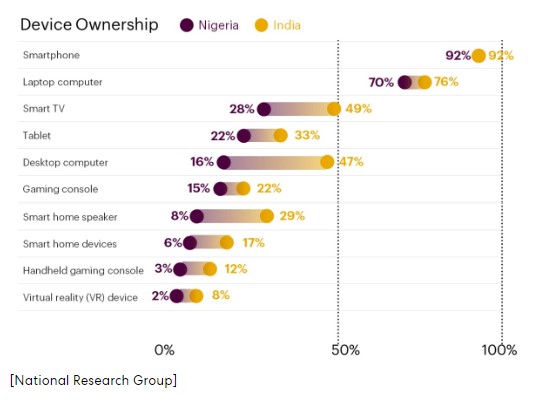
But beyond that, mobile is a godsend for Nigerians living with the state’s still relatively poor electricity infrastructure, says Samuel Odusami of SBI Media, the Nigeria-based agency that served as NRG’s local partner on the ground. “Because [Nigerians] don’t have access to uninterrupted power 24/7, mobile technology has become their savior,” says Odusami, adding that power-bank businesses have boomed in Nigeria, helping many stay wired to the internet for longer, on the road or at home, when the grid is down.
Consequently, the often-slow speed of internet is viewed as the biggest tech problem in the market, one that many hope the 5G revolution will solve. Nearly 70% of those surveyed are aware of the impending 5G rollout, and 81% of Nigerians believe it will “transform my country for the better.” In rural and low-income communities, where internet connections are spottiest, many believe 5G offers a chance to “catch up,” as faster streaming translates into more business productivity, the report notes.
“It’s a democratization of access across all socioeconomic classes,” says Anas Ghazi, Stagwell’s chief strategy officer. “It’s allowed for an entrepreneur mindset, as Nigeria [pursues] its largest revenue generation in the next five years.”
THE SKITMAKER HUSTLE
That entrepreneurial spirit of capitalism and “hustle culture” has long reigned in Nigeria, even as unemployment rates increased and the economy struggled. But now, it’s being supercharged by Nigeria’s largest population of youth in the world—skewing the country’s median age to just 18 years old—who have seized upon the internet as a way out of the well. “It’s a window of opportunity for young people,” says Odusami, who cites a rising generation of so-called skitmakers as proof.
Nigerian skitmakers create social media content, but they do it without the popular influencer luxuries—studios to shoot videos, or pricy tools for animation—choosing to invest only in a high-end smartphone, perhaps an iPhone or Samsung Galaxy, to stitch together content for YouTube, TikTok, and other platforms.
The goal is to go viral, and many have flocked to try. The country now has a nest of creators numbering in the thousands—including some with millions of views, says Odusami—who have used their success as a springboard to start full-fledged production companies, even in the mainstream movie industry. Collectively, skitmaker startups employ close to 5,200 people, he says. Among the most prominent is Mr Macaroni, who broke through with YouTube comedy and now tours the world promoting Nigerian issues.
For those who don’t strike it big, skitmaking might be just one of many enterprises. “Even people with 9 to 5 jobs have what we call ‘side hustles,’” says Odusami. “In Nigeria, you can’t [support] a family without multiple streams of income.” They might start blogs or YouTube channels, or they might start a business that has nothing to do with social media—but the internet remains a through line. Learning to code, or leveraging e-commerce to sell Nigerian cuisine in foreign countries, are among the examples he cites.
But despite the hustle, Nigerians still feel “behind” on tech development, NRG’s report finds. Only one in three survey respondents said their country was currently “very innovative,” compared to over half of respondents in India, which served as a pseudo-control group for the study.
According to Odusami, Nigerians hope the grind can help bridge the gap. “They are hungry to feed themselves,” he says. “Hungry to make a name, hungry to become financially independent.”
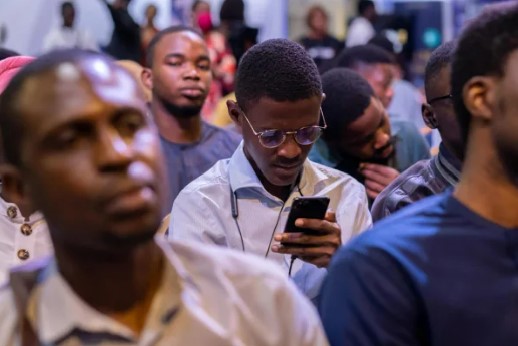
CRYPTO UNLOCKED
As businesses grew, Nigerians needed a way to accept payments globally—something that wasn’t possible with PayPal, Google Pay, or other legacy platforms. That ignited a boom in enthusiasm for cryptocurrencies and blockchain technology, one that has dwarfed awareness of crypto in the United States. In Nigeria, 90% responded that they were aware and knowledgeable about cryptocurrencies, while 71% said the same for the blockchain and 59% for NFTs. (In a November 2021 Pew Research report, only 24% of Americans said they had heard “a lot” about crypto.)
“Now you have businesses who accept payments in crypto, in stablecoins like USDC and Binance Coin,” says Odusami. But even as people began to adopt crypto for everyday goods like groceries and taxi rides, the Nigerian government’s central bank in 2021 began to restrict Bitcoin services in the country. According to a recent joint report from the Organisation for Economic Co-Operation and Development (OECD) and the United Nations, the crackdown crippled “millions of young Nigerians” who were making money from crypto trading. However, the report also suggested that some found a way to “lawfully bypass these restrictions and continue the business.” The same month, crypto exchange KuCoin reported that 33 million Nigerians had owned or traded crypto in the last half year.
According to Odusami, 20 to 30 global crypto exchanges have a presence in Nigeria and are actively targeting Nigerian customers—including Binance, which is a client of SBI Media in five African countries.
Meanwhile, the hustle has moved onto the blockchain. Odusami cites the story of a Nigerian man who created his own NFT project from photos of drummers at a traditional Nigerian wedding ceremony—a cultural rite beloved not just in dance, but also as a musical retelling of the betrotheds’ mothers and fathers through the years. The man made a killing—and returned to the ceremonial village to give the drummers 70% of the proceeds.
BIG TECH’S SWAY
According to the survey, Silicon Valley Big Tech companies (including social media) wield tremendous influence in Nigeria, with their command of the culture second only to religious institutions. It tops that of colleges and universities, as well as the government, and both Hollywood and Nollywood.
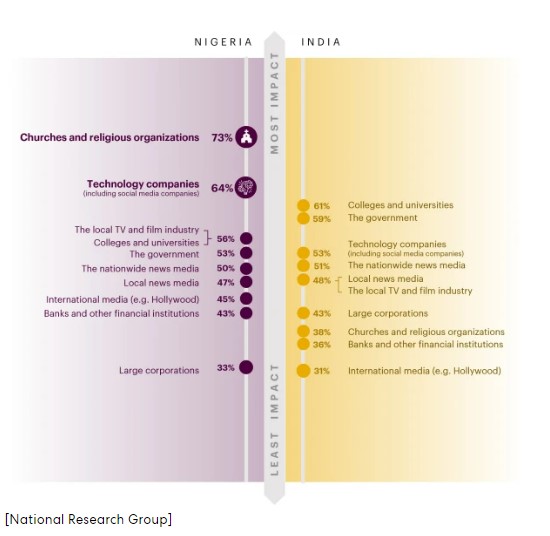
It’s perhaps no surprise that giants of crypto and social media—which have speckled reputations in the States—are viewed much more positively in Nigeria, because, as Norton explains, the impact of both technologies within the country has been overwhelmingly positive. It offers freedom of entrepreneurship and liberation from circumstances, a lifeline that keeps Nigerians afloat, and working, and connecting with the rest of the world. It might even have the power to combat corrupt governments and state overreach.
But Nigeria is young, and it will still have to fight for its place in a competitive world. “Nigeria is on the map to grow significantly over the next 10, 15, even 5 years,” says Norton. “They want to be where the future is.”
So, it hustles on.
Related
Articles
Artificial Intelligence, In the News, Marketing Frontiers, Press Releases, Stagwell Marketing Cloud, Tech
Jun 12, 2025
PRophet, a Stagwell (STGW) Company, Completes Integration of UNICEPTA, Launches Unified Brand and Enhanced Media Intelligence Offering

In the News, Marketing Frontiers, Press Releases, Stagwell Marketing Cloud, Tech
Jun 11, 2025
The Marketing Cloud Launches Cutting-Edge Platform to Simplify Marketing Workflows

In the News, Press Releases, Thought Leadership
Jun 10, 2025
Stagwell (STGW) Chairman and CEO Mark Penn to Discuss the Irreplaceable Power of Human Creativity on the Main Stage of Cannes Lions

By: Ray Day
CONTACT:
We wanted to share our latest consumer and business insights, based on research from The Harris Poll, a Stagwell agency.
Among the highlights of wave 139 (fielded Oct. 21-Oct. 23) in our weekly consumer sentiment tracking:
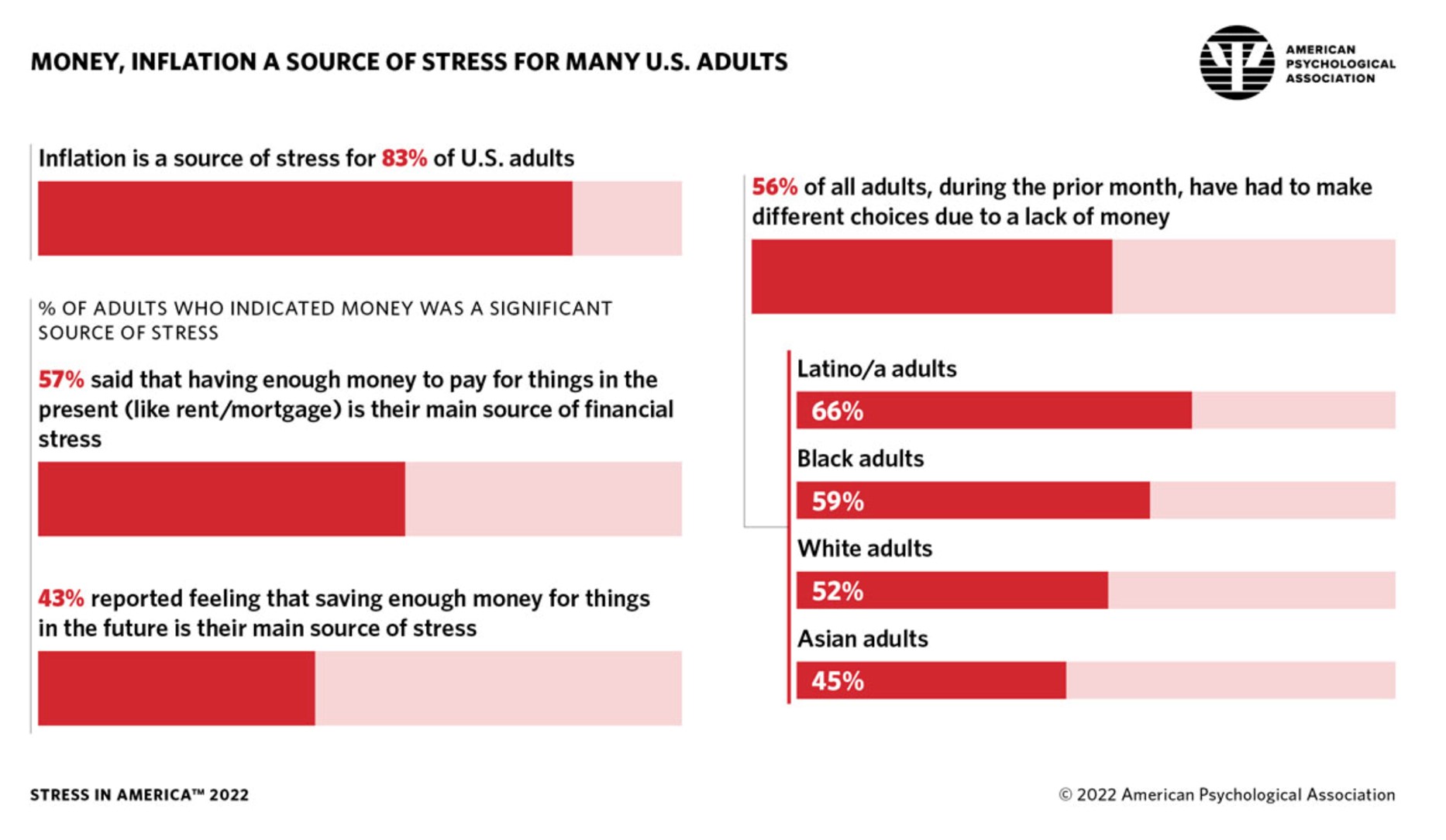
ECONOMY, INFLATION WORRIES REMAIN STEADY:
Today, 89% of Americans are concerned about the economy, inflation and jobs – the same high level as last week.
-
- 85% worry about a potential U.S. recession (no change)
- 82% about U.S. crime rates (down 1 point)
- 75% about political divisiveness (up 1 point)
- 74% about the War on Ukraine (no change)
- 72% about affording their living expenses (down 1 point)
- 61% about a new COVID-19 variant (up 1 point)
- 47% about losing their jobs (no change)
- 44% about the Monkeypox outbreak (down 4 points)
INFLATION IS AMERICA’S #1 STRESSOR:
How stressed are Americans, and what’s causing it? The answers are clear in the 2022 Stress in America survey we conducted with the American Psychological Association.
-
- 27% of Americans report being so stressed that they cannot function most days.
- Inflation is the #1 stressor for 83% of adults. That is followed by violence and crime (75%), the current political climate (66%) and the racial climate (62%).
- 76% say the future of the nation is a significant source of stress in their lives.
- 68% say this is the lowest point in our nation’s history that they can remember.
- 57% who indicated money was a worry said that having enough money to pay for things like food or rent/mortgage is their main source of stress.
- 43% reported feeling that saving enough money for things in the future is their main source of stress.
- 56% agreed that they and/or their family have had to make different choices due to lack of money in the past month, with Latino/a (66%) and Black Americans (59%) reporting this at a higher level than White (52%) and Asian (45%) American adults.
EMPLOYEES WARMING UP TO BACK-TO-OFFICE:
As we continue tracking return-to-office requirements, a majority of employees still say they will jump jobs if forced back to the office full-time. Yet the numbers of workers resisting return-to-office are much lower than three months ago, based on our survey with USA Today.
-
- 57% of employed Americans say companies will lose employees if they require workers to be in-person (down 9 points from June).
- 73% of remote and hybrid workers say they would find another remote or hybrid job if their company forced them to work from the office full-time (down 5 points from June).
- In an earlier study with Bloomberg, 57% of workers said they believe that employers now have more power in the job market (a 5-point increase in favor of employers from January).
INFLUENCERS MATTER:
Nearly half of U.S. consumers consider input from influencers when purchasing a product or service – especially younger people, according to our survey with AdAge.
-
- 80% of Gen Z consult user reviews before purchasing, and 75% say that recommendations from influencers affect their decision – nearly double the general population at 43%.
- 40% of Gen Z members have made purchases directly through an influencer’s storefront on sites like Amazon and LTK.
- 73% also report looking to TikTok creators for product input, with Instagram and YouTube influences being similarly popular choices.
BRANDS GETTING GEN Z RIGHT:
Beats by Dre, Jersey Mike’s Subs, Planned Parenthood, Lenovo and New Balance are doing the right things to capture the attention of Gen Z, according to the latest Ad Age-Harris Poll Gen Z brand tracker, a ranking of brands gaining the most attention from Gen Z members ages 18-24 in the third quarter.
-
- Also doing better with Gen Z are Kickstarter, Impossible Foods, Coach, Flex Seal, Foot Locker, Pillsbury, Haagen-Dazs, Bose, Nature Valley, North Face, Crocs, NHL, Paramount, Fiji and State Farm.
- See full details here.
ICYMI:
In case you missed it, check out some of the thought-leadership and happenings around Stagwell making news:
As always, if helpful, we would be happy to provide more info on any of these data or insights. Please do not hesitate to reach out.
Thank you.
Related
Articles
In the News, Press Releases, Thought Leadership
Jun 10, 2025
Stagwell (STGW) Chairman and CEO Mark Penn to Discuss the Irreplaceable Power of Human Creativity on the Main Stage of Cannes Lions

Events, In the News, Press Releases, Talent & Awards
Jun 05, 2025
Code and Theory Named ANA B2B Agency of the Year After Transforming the World’s Leading Brands

In the News, Press Releases, Talent & Awards
May 19, 2025
Stagwell (STGW) Appoints Connie Chan as Chief Growth Officer for Asia Pacific

Newsletter
Sign Up
By
By: Maggie Malek, CEO, MMI Agency
Originally Released on
The Marketing Insider
CONTACT
hello@stagwellglobal.com
SIGN UP FOR OUR INSIGHTS BLASTS
One of the great loves of my life (and one of my best kept secrets — until now) is gaming.
I have spent so much time online playing games, but it’s something I never talk about. Why? Maybe it’s because I’m a woman. Maybe it’s because I’m a CEO. Maybe I’m afraid I won’t be taken seriously.
But that time is past. It is now time for me to “step out of the shadows,” especially as an advocate for women in advertising, marketing and business in general, because now there is a particularly compelling reason to discuss it.

Thinking like a gamer is a superpower. Considering all the talk about gaming around us, the ability to understand that storytelling environment — or, how to “think like a gamer” — is an enormous asset. It’s estimated the global gaming market will amount to $268 billion annually in 2025. The opportunities for brands in this space are nearly limitless.
Using gaming to engage and convert. You can’t change hearts and minds with a big idea alone. Connecting and converting the modern consumer is all about meeting them where they are, in the thick of the customer journey, where multiple touchpoints build a lasting connection with your brand. It is that point where gaming can be… well, a game-changer.
As an audience segment for advertisers, gaming has been somewhat on the fringe. Brands and advertisers have generally not understood how to engage. As the space becomes more mainstream, though, opportunities for brands that are willing to explore are growing.
Successful campaigns start where brand followers are consuming content online.
That is where we should be telling stories. And we know gamers have active audiences that drive conversion. Gaming truly is the convergence of performance and possibility.
Gaming is only getting bigger. As marketers, though, we’ve really only scratched the surface; gaming is now everywhere. Women make up 45% of gamers in the U.S., which has been the case for a decade. The average age of gamers is 31, and 80% of all gamers are over the age of 18. According to Nielsen, 58% of the total U.S. population in 2013 were gamers. Today, it’s grown to 72%.
The opportunity for brands to create content for this massive (and growing) audience, then, is incredible, and it’s particularly exciting to see these possibilities opening up in the industry I love.
A lifelong gamer. From growing up battling my dad on our PC with Star Wars race games and Lemmings, to my first Game Boy, to my limited edition blue Sega Genesis, I have always been playing. Today, I’ve graduated to an array of games, from my Nintendo Switch to PokemonGO on my phone — and can we talk about how Edith Finch is the most beautiful game of all time!?
In fact, I run a Discord group for gamers, because we wanted to make sure there was a positive (no trolls allowed) corner of the internet for people to go. That group and its members were already a happy place for me, and then when I later got to meet the Discord team at a Stagwell SXSW event… major fan girl moment!
What’s next?
It’s practically a fait accompli that, moving forward, gaming is going to be a part of brands’ advertising media mix. Brands need to explore partnerships from in-game product placement to sponsoring gaming influencers, and partnering with all the social networks that focus on gaming.
No matter the story you are trying to tell, it’s now increasingly likely that a portion of your audience is spending time with gaming communities online. If you aren’t creating content there, you are missing out on rich engagement.
Gaming is the evolution of influencer marketing; it’s the evolution of CTV and display networks, of VR. And it’s the next stage of the industry we’re in. As the conversation on opportunities for branded content in games grows and evolves, brands will benefit from working with agencies that actually understand the space.
Related
Articles
Artificial Intelligence, In the News, Marketing Frontiers, Press Releases, Stagwell Marketing Cloud, Tech
Jun 12, 2025
PRophet, a Stagwell (STGW) Company, Completes Integration of UNICEPTA, Launches Unified Brand and Enhanced Media Intelligence Offering

In the News, Marketing Frontiers, Press Releases, Stagwell Marketing Cloud, Tech
Jun 11, 2025
The Marketing Cloud Launches Cutting-Edge Platform to Simplify Marketing Workflows

In the News, Press Releases, Thought Leadership
Jun 10, 2025
Stagwell (STGW) Chairman and CEO Mark Penn to Discuss the Irreplaceable Power of Human Creativity on the Main Stage of Cannes Lions

Newsletter
Sign Up
By: Ray Day
CONTACT:
We wanted to share our latest consumer and business insights, based on research from The Harris Poll, a Stagwell agency.
Among the highlights of wave 138 (fielded Oct. 14-Oct. 16) in our weekly consumer sentiment tracking:
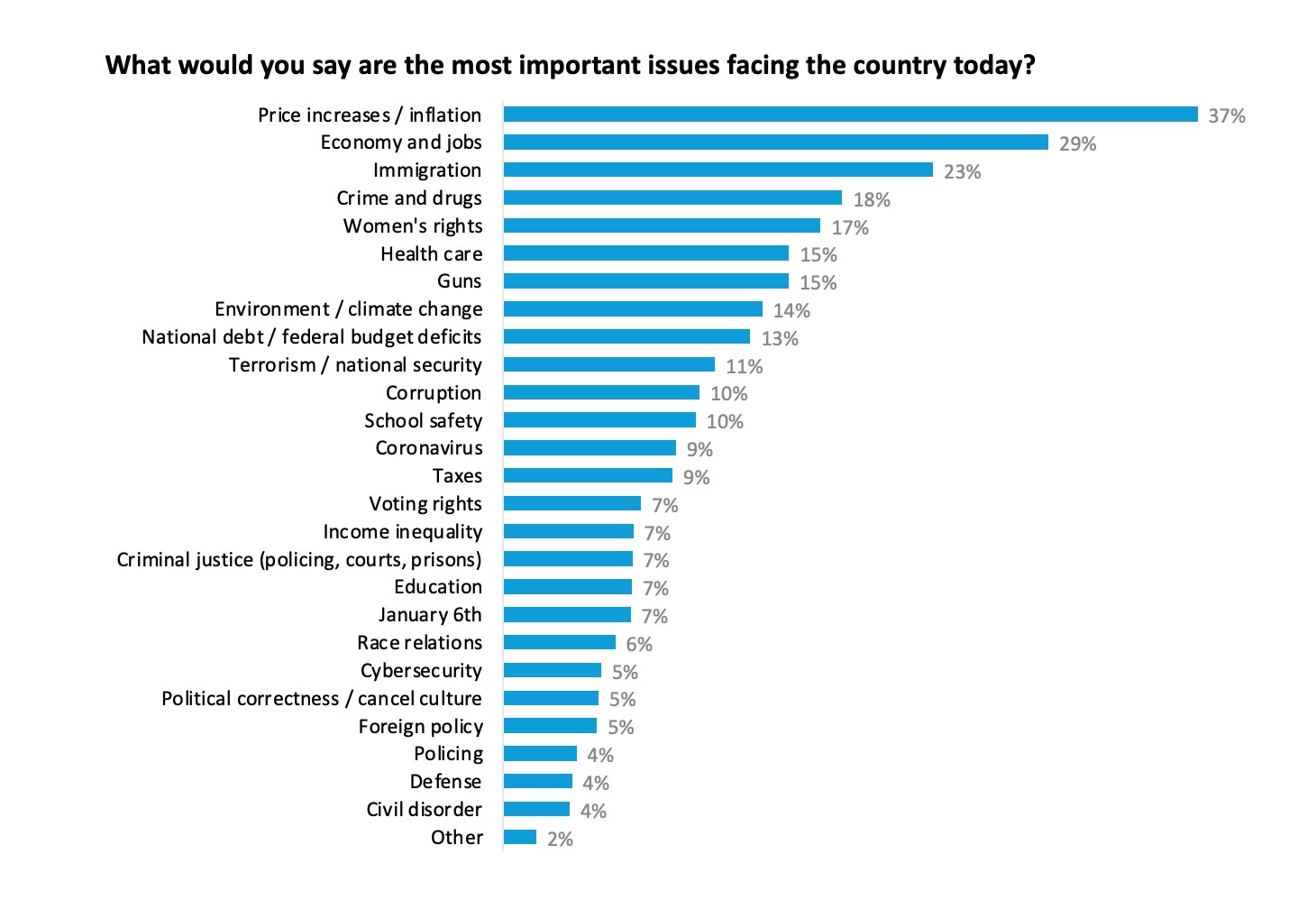
ECONOMY, INFLATION WORRIES UP AGAIN:
Today, 89% of Americans are concerned about the economy, inflation and jobs – up 3 points from last week.
-
- 85% worry about a potential U.S. recession (up 3 points)
- 83% about U.S. crime rates (up 2 points)
- 74% about political divisiveness (up 1 point)
- 74% about the War on Ukraine (up 1 point)
- 73% about affording their living expenses (no change)
- 60% about a new COVID-19 variant (up 3 points)
- 48% about the Monkeypox outbreak (up 1 point)
- 47% about losing their jobs (down 1 point)
VOTERS SEE ECONOMY ON NOVEMBER BALLOT:
Mid-term elections are less than three weeks away, and inflation and the economy might be casting the deciding votes, according to our latest survey with Harvard’s Center for American Political Studies.
-
- When asked to pick the most important issues facing the country today, voters identified inflation (37%), the economy and jobs (29%), immigration (23%) and crime (18%).
- 73% believe inflation is increasing (versus 12% who say it is moderating and 14% who say it is staying the same).
- 65% think the U.S. economy today is weak (versus 35% who say strong), and 57% say their financial situation is worse (up 20 points from a year ago).
- 84% think the U.S. is in a recession now or will be in the next year.
- 65% oppose easing sanctions on countries like Iran and Venezuela to lower gas and oil prices. Instead, they want greater output of American oil and gas.
- 54% think the U.S. should cut military sales and technical aid to the Saudi Arabian government in response to its oil production cut.
NO KIDS = FREEDOM, MILLENNIALS SAY:
Americans are having fewer children than are needed to keep population numbers stable. Yet why are people choosing not to have children? In our survey:
-
- Of those without children, 52% do not want to have a child in the future, while 20% remain unsure.
- For those who have decided against having children, 54% want to maintain their personal independence/finances, 40% want work-life balance, 33% say it’s due to housing prices, 31% cite the current political situation, 31% say it’s because of safety concerns, and 28% cite climate change.
- 55% of men and 53% of women reported that their desire to maintain independence influences their decision not to have children.
- 65% agree that the freedom that comes with not having kids brings them happiness – increasing to 73% among Millennials, according to a similar survey with Fortune.
CREDIT SCORES IMMUNE FROM PANDEMIC:
The pandemic disrupted many Americans’ finances, yet that did not translate into lower credit scores, according to our survey with NerdWallet.
-
- 27% of Americans say their credit score has gone up since the beginning of the COVID-19 pandemic, with just 14% saying it declined.
- 69% with increasing credit scores attribute the gain to paying down debt.
- For those who saw their scores drop, 47% attribute it to taking on or increasing debt.
- 65% with higher credit scores took financial action as a result, such as applying for a rewards credit card (30%) or a mortgage/home equity line of credit (25%).
- 61% of Americans plan to act during the next year to improve their credit scores, with half (49%) planning to pay off or pay down debt.
- Still, credit misconceptions remain, with 46% of Americans incorrectly believing that closing a credit card you don’t use can help improve a credit score.
1 IN 4 ARE HALLOWEEN CANDY LOYALISTS:
With Halloween around the corner, our survey with Instacart has revealed consumers’ latest candy-buying habits.
-
- 72% of Americans say they like Halloween.
- 24% say Halloween is their favorite holiday.
- 84% of people who buy Halloween candy will buy chocolate, while 56% will purchase fruity and chewy candy.
- 23% of Americans are candy loyalists – with 65% buying the same Halloween candy for five or more years, and 40% buying the same types of Halloween candy for 10 or more years.
- 63% of Americans report they now love a type of Halloween candy that they hated as a kid. Of those, 29% say they now love licorice, an 28% have developed an affinity for candy corn.
ICYMI:
In case you missed it, check out some of the thought-leadership and happenings around Stagwell making news:
- From National Research Group’s latest in-depth study: In Nigeria, Big Tech, crypto, and hustle culture come calling
- From a recent study by The Harris Poll: Social media fuels OOH visibility according to OAAA, Harris Poll
As always, if helpful, we would be happy to provide more info on any of these data or insights. Please do not hesitate to reach out.
|
|
Thank you.
Related
Articles
In the News, Press Releases, Thought Leadership
Jun 10, 2025
Stagwell (STGW) Chairman and CEO Mark Penn to Discuss the Irreplaceable Power of Human Creativity on the Main Stage of Cannes Lions

Events, In the News, Press Releases, Talent & Awards
Jun 05, 2025
Code and Theory Named ANA B2B Agency of the Year After Transforming the World’s Leading Brands

In the News, Press Releases, Talent & Awards
May 19, 2025
Stagwell (STGW) Appoints Connie Chan as Chief Growth Officer for Asia Pacific

Newsletter
Sign Up
By
Mark Penn
Chairman and CEO, Stagwell
CONTACT
hello@stagwellglobal.com
SIGN UP FOR OUR INSIGHTS BLASTS

When I ran campaigns, I used to lament that corporations would spend more on marketing a hamburger than marketing political ideas and efforts. Back then, campaigns were struggling shoestring enterprises. No longer.
Today, campaigns and issue groups spend billions of dollars (much of it ineffectively) on communicating to voters, and fundraising at large has become big business. Ironically, the rocket fuel for all this was not the much-maligned Supreme Court decision Citizens United that gave corporations political speech rights. Rather, it was the internet – opening up a far speedier and cost-effective method of motivating voters and fundraising from them. Everything we condemn about politics and social media today – the speed of clickbait, the sensationalizing of small news events, the partisan divide – has paved the way for online fundraising and its explosive growth.
Political advertising spend is rapidly breaking records
Political advertising will hit $7.8bn in the 2022 midterm elections – nearly approaching the $8.5bn spent across TV, radio and digital media in the 2020 presidential cycle. We are seeing continued growth in campaign spending, and each mid-term is coming close to the previous presidential runs in spend. Each president leaps to a new record in political expenditures. It will take a set of really mundane candidates with a runaway winner to break this ever-increasing cycle. Absent that, this is a double-digit growth spiral for several more election cycles. I never thought I would see $10m Congressional races and $100m Senate contests, and yet those are now everyday occurrences.
Digital fundraising is rising at a faster rate than overall spending
Of the $14.4bn in paid media spent during the 2020 cycle, 49% was raised online. The 2022 cycle should exceed $14bn in paid media spend, with over 60% likely to come from online fundraising. To put that in context – in 2014, less than 9% of the $4.4bn in contributions came in via online donors. Democrats, who are notably vocal about money in politics, spend the most – generally about 50% more than the Republicans.
Donors today are largely first-timers – and start small
For most donors over the last few cycles, giving to politics has been a new experience. Most of these contributions aren’t from big-dollar donors or PACs, but low-dollar donations from average Americans giving amounts between $30 and $100 (76.1% of Act Blue Democratic donors in 2020 were first-time donors).
Americans have a love-hate relationship with political giving. When asked to give $1 on their tax return to fund campaigns, most Americans said ‘no’ to the voluntary check-off, and the fund was running out of money. Taxpayers generally believed politicians should finance their own campaigns and leave the public out of them. In the ‘70s and ‘80s, candidates used direct mail to gather low-dollar gifts, but it was slow and expensive. In 2008, social media entered the scene and spilled over into news and politics. With its proliferation of inflammatory messages and clickbait, social media was the ideal incubator for online giving. While less than 1% of voters donated to campaigns in the past, that number is now up to 10% and continues to grow.
How companies can mimic political fundraising techniques
I always call online fundraisers the best marketers in the world. Why? Because in return for their funds, consumers get absolutely nothing of tangible value – no product and not even a tax deduction.
What makes them such good marketers? They believe in math. They have hundreds of people who craft messages, then test them methodically and go big with the ones that work. They refine their lists, carefully managing their communications to people to avoid overload or confusing and contradictory messages. And they utilize low-cost, effective messaging techniques, driving campaigns through email and increasingly via text messaging, as consumers switch their preferred communication modes.
Today, these fundraisers employ the process and rigor that most corporations should envy: ample message creation, thorough testing, careful media mix modeling and rigorous adherence to performance standards and return on investment. Politics once again leads the way in how to structure and carry out effective online marketing. This rigorous approach would and is working for commercial online marketing, though retail marketers have more limits on how aggressive they can be. Still, they can treat Thanksgiving, Prime Days and Christmas as a kind of commercial election day, working up to harvesting sales in the same way that political fundraising is mostly prospecting until the campaign’s final months. Commercial marketers can also be more aggressive via text messaging to mimic these successful political messages.
Political fundraising is only starting to hit its groove and has many potential roads for broad expansion. While online fundraising exploded in 2020, only 20% of the 180 million Americans who voted in that cycle donated to a campaign, and under 2% of the country gave over $200. By comparison, over 70% of Americans gave to charity in 2020, totaling $324.1bn in individual contributions that mirror the scale and spend of small-dollar political contributions. The addressable digital advocacy and political fundraising markets represent massive growth opportunities.
Galvanizing the masses around a cause: still the mandate
Online political fundraising is, in essence, fan marketing. It’s about getting those who care most about your brand to be even more passionate and committed. When an employee of a competitor company insults a customer, don’t just sit there – use it to your advantage and broadcast it to your loyal fans. Most commercial marketing, even online, is passionless and saccharine; if you want to be as successful as political marketers, you will have to take some risks and be bolder. Now, this may not fit all corporate brands, but that’s the advantage that upstart challenger brands have in the marketplace – they can be free to be out there, within the bounds of good humor and taste.
To be clear, political ads continue to be a discipline unto themselves, built primarily around negative messages with no clear analog in commercial marketing. Online fundraising also includes tough negative messages, but is built mainly around bringing people together as part of a group that wants to help a cause. This new technique is at the forefront of what’s possible in this new online world as more and more people are plugged into news and current events. Online fundraising can and will expand into the not-for-profit world, but it will surely lead the way in fan marketing for breakthrough companies as well.
Mark Penn is chairman and chief executive officer of New York-based marketing group Stagwell.
Related
Articles
Artificial Intelligence, In the News, Marketing Frontiers, Press Releases, Stagwell Marketing Cloud, Tech
Jun 12, 2025
PRophet, a Stagwell (STGW) Company, Completes Integration of UNICEPTA, Launches Unified Brand and Enhanced Media Intelligence Offering

In the News, Marketing Frontiers, Press Releases, Stagwell Marketing Cloud, Tech
Jun 11, 2025
The Marketing Cloud Launches Cutting-Edge Platform to Simplify Marketing Workflows

In the News, Press Releases, Thought Leadership
Jun 10, 2025
Stagwell (STGW) Chairman and CEO Mark Penn to Discuss the Irreplaceable Power of Human Creativity on the Main Stage of Cannes Lions


